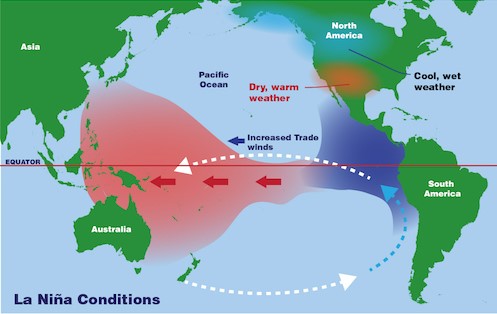La Nina
2022 SEP 21
Preliminary >
Geography > Climatology > Climatology
Why in news?
- The World Meteorological Organization (WMO) is predicting that the current La Nina phase will likely continue for the next six months, making it a Triple dip La Nina.
About La Nina:
- La Nina is a coupled ocean-atmosphere phenomenon in the Pacific Ocean.
- During a period of La Nina, the sea surface temperature across the equatorial Eastern Central Pacific Ocean will be lower than normal by 3 to 5 °C.
- An appearance of La Niña persists for at least five months.
- It has extensive effects on the weather across the globe, particularly in North America, even affecting the Atlantic and Pacific hurricane seasons, in which more tropical cyclones occur in the Atlantic basin due to low wind shear and warmer sea surface temperatures, while reducing tropical cyclogenesis in the Pacific Ocean.
- La Nina is thought to cause drought in the South American countries of Peru and Ecuador, heavy floods in Australia, high temperatures in Western Pacific, Indian Ocean, off the Somalian coast and a comparatively better south west monsoon rains in India.
 ???????
???????
Why does it happen?
- La Niña is a complex weather pattern that occurs every few years, as a result of variations in ocean temperatures in the Equatorial Pacific.
- It occurs as strong winds blow warm water at the ocean’s surface from South America across the Pacific Ocean towards Indonesia.
- As this warm water moves west, cold water from the deep sea rises to the surface near South America
- La Nina, along with El Nino is part of the broader El Niño–Southern Oscillation (ENSO) climate pattern.
El Nino–Southern Oscillation (ENSO):
- El Niño–Southern Oscillation (ENSO) is an irregularly periodic variation in winds and sea surface temperatures over the tropical eastern Pacific Ocean, affecting the climate of much of the tropics and subtropics.
- The warming phase of the sea temperature is known as El Niño and the cooling phase as La Niña.
La Nina’s impact on India:
- Increase in precipitation:
- Due to La Nina, the South-West monsoon has extended its tenure by three weeks in 2021, bringing more precipitation in October.
- Harsh winters:
- In a La Niña year, equatorial winds blow much stronger during the winter, which makes the water near the equator a few degrees colder than normal.
- It would translate into intermittent waves of extremely cold weather, instead of a dip in temperatures throughout the season.
- Other weather anomalies:
- Rare episodes like the “frost in Mahabaleshwar” and “cold waves in hilly parts of Tamil Nadu” can be associated with La Niña episodes.
- Favorable for agriculture:
- Weak La Nina conditions have generally been favorable for Kharif crops.
- Longer precipitations result in increase in agricultural production from the rainfed areas and thus strengthen food security. However, sensitivity of different crops to La Nina episodes is not uniform for all the regions.
- Impact on global agricultural trade:
- The weather phenomenon is already creating an impact on the global production and price of crops such as wheat, coffee, sugarcane, palm oil.
- Global agricultural prices have shot up between 8 and 15 per cent in the last two months including wheat (up 14 per cent), maize (up 14.7 per cent) and sugar (up 9.3 per cent). This can affect India’s Agri export-imports sector.
- Potential hazards:
- While the cooling can reduce incidents of cyclones along Indian coasts, the erratic rainfall has the potential to create floods.
- Also, the added agricultural produce can generate deflationary trends in the country if not properly regulated.
PRACTICE QUESTION
Which of the following statements are correct?
1. During a period of La Nina, the sea surface temperature across the equatorial Eastern Central Pacific Ocean will be lower than normal
2. La Nina brings comparatively better south west monsoon rains in India
Select the correct answer using the code given below:
(a) 1 only
(b) 2 only
(c) Both 1 and 2
(d) Neither 1 nor 2
Answer
 ???????
???????